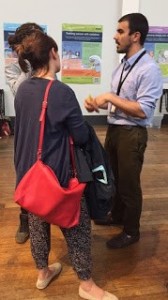 Carlotta Taddei is a 2nd year PhD student in the Division of Imaging Sciences & Biomedical Engineering. Her research is about the development of radiopharmaceuticals and radiochemicals for medical diagnostics and research. Here she talks about her involvement in an international collaboration and her secondment in Amsterdam.
Carlotta Taddei is a 2nd year PhD student in the Division of Imaging Sciences & Biomedical Engineering. Her research is about the development of radiopharmaceuticals and radiochemicals for medical diagnostics and research. Here she talks about her involvement in an international collaboration and her secondment in Amsterdam.
I am part of a project called RADIOMI which is supported by the Marie-Curie Action Innovative Training Networks and has the goal to provide training to produce new talent and innovation in radiochemistry for molecular imaging. The emphasis of this network is focused on training scientists to develop and carry-out innovative radiolabeling with short half-life positron emitting isotopes such as Fluorine-18, Carbon-11 and Nitrogen-13. These novel and improved methodologies will be trialed in the synthesis of known and new radiotracers, such as small molecules, peptides and libraries of biologically active labelled compounds.
 The project combines the expertise of leading scientists in radiochemistry around Europe – the University of Oxford, King’s College London, University of Turku, VU University Medical Center Amsterdam, University Claude Bernard Lyon, Medical & Health Science Center Debrecen, CIC BiomaGUNE San Sebastian, Advanced Accelerator Applications and several other associate partners, such as GE Healthcare, Advion, Synthra GmbH and BV Cyclotron VU.
The project combines the expertise of leading scientists in radiochemistry around Europe – the University of Oxford, King’s College London, University of Turku, VU University Medical Center Amsterdam, University Claude Bernard Lyon, Medical & Health Science Center Debrecen, CIC BiomaGUNE San Sebastian, Advanced Accelerator Applications and several other associate partners, such as GE Healthcare, Advion, Synthra GmbH and BV Cyclotron VU.
Currently I am part of a group of 15 fellows, 13 Early Stage Researchers and 2 Experienced Researchers. We gather together with our supervisors, advisory board and associate partners every 6 months. During these international meetings we present our individual reports and receive valuable feedback on the ongoing research and suggestions for our future work. So far, there have already been 3 RADIOMI Schools and International meetings, with additional courses at the partner universities. Next meeting will be in November 2015 at CIC BiomaGUNE San Sebastian in Spain with the distinguished international Molecular Imaging Workshop 2015.

As part of the RADIOMI project, the ESR fellows have to carry out research projects in collaboration with the other RADIOMI partner universities, so-called secondments. Our department hosted Aleksandra Pekosak and Ulrike Filp, two ESR RADIOMI fellows from VUmc Amsterdam, during June 2015. We carried out a small research project on carbon-11 chemistry related to our PhD topic. This work continued at VUmc during my secondment period there in August 2015.
 Before I arrived in Amsterdam, I was looking forward to carrying out radiochemistry work in a different institution to gain more skills in this field. Personally I think it was a very interesting and fruitful experience. Planning and performing radiochemistry work in a different radiochemistry centre having different rules was good training for me. Luckily we managed to obtain some good preliminary results on our research topics in order to continue our work at our corresponding institutions and strengthen the collaboration between the two partner universities.
Before I arrived in Amsterdam, I was looking forward to carrying out radiochemistry work in a different institution to gain more skills in this field. Personally I think it was a very interesting and fruitful experience. Planning and performing radiochemistry work in a different radiochemistry centre having different rules was good training for me. Luckily we managed to obtain some good preliminary results on our research topics in order to continue our work at our corresponding institutions and strengthen the collaboration between the two partner universities.
I really enjoyed this secondment because it gave me a better understanding of team-work and time-management which can be really useful skills in my research field. In the future I hope to have similar work experience to this and grow my international collaborations so that my research can have an impact in this fascinating field.








